Contributory members are able to log private notes and comments about each site
Sites TheCaptain has logged. View this log as a table or view the most recent logs from everyone
Langrais menhirs
Trip No.212 Entry No.6 Date Added: 26th Mar 2020
Site Type: Standing Stones
Country: France (Normandie:Calvados (14))
Visited: Yes on 7th May 2012. My rating: Condition 4 Ambience 3 Access 4

Langrais menhirs submitted by Rida on 27th Feb 2011. Site in Normandie:Calvados (14) France
(View photo, vote or add a comment)
Log Text: Having had a good look at the IGN 1:25000 map, I saw that there is a trackway running east from the road south of Mont Joly, which runs from the bottom of the hill diagonally up to the approximate position of the stones. Even better, when arriving there for a look, the trackway was open and easily driveable, and so I took this option on this showery afternoon, and when emerging from below the wood at the top of the hill, there was plenty of space to park amongst a large composting area! Left Dad in the car while I went out into the wind and drizzle to find the stones, and there they were, just round the back of the big pile of manure!
The two stones stand at the edge of an open rocky outcrop at the top of the hill, covered in wildflowers at this time of year, but I learned that the stones are not in their original positions, having been moved there by the farmer at some point in the past. The two stones are very different, the larger stone being a whitish quartz type stone, between 3.5 nd 4 metres tall, while its shorter neighbour is a reddish colour, and only about 1.6 metres tall. There are plently of other large lumps of stone laying about here, which may have been broken from the two menhirs, or just other examples of field clearance.
On the way down from the stones, through a gateway into the wood I could see another rocky outcrop with various large stones standing around, a couple of them probably at least 2 metres tall. This was all now made into a nice garden feature, but is there any ancient significance to the stones? Back onto the road, and I noticed it was called Route des Menhirs, and up towards the top of the hill there was another garden with some large rocks standing in it.
Onto the top of Mont Joly, and it is clear that there are large rocks all over the place, and it is easy to imagine that thee was once an alignement of large stones running along the top of the hill into the ancient settlement. Walking along the edge of the field, and then the pathway to the end of the promontary, and large stones can be seen laying around everywhere, many clearly not just a local outcropping of rock, but various shapes, sizes and types of stone. Many of these rocks were now incorporated into garden features, but many more are just laying there, slowly getting buried by the undergrowth. It really is a fascinating area, and I do wonder what a proper survey of this ancient hilltop would turn up.
Langrais menhirs
Trip No.202 Entry No.12 Date Added: 26th Mar 2020
Site Type: Standing Stones
Country: France (Normandie:Calvados (14))
Visited: Saw from a distance on 23rd Apr 2005
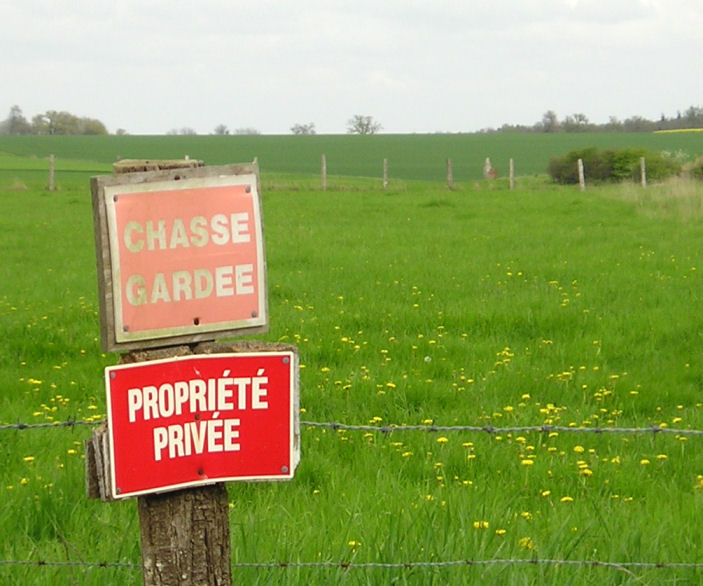
Langrais menhirs submitted by TheCaptain on 6th May 2005. Langrais menhirs, Soumont-Saint-Quentin, Calvados.
2 large menhirs in a field to the east of the village near Mont Joly, but which are 500 metres from the road across a field surrounded by barbed wire and with very clear keep out signs. One of the two menhirs stands 3.6 metres high, while the other is fallen.
The standing menhir can be seen here between the third and fourth fencepost along to the right of the sign.
(View photo, vote or add a comment)
Log Text: Two large menhirs in a field to the east of the village near Mont Joly but which are 500 metres from the road across a field surrounded by barbed wire and with very clear keep out signs. One of the two menhirs stands 3.6 metres high while the other is fallen.
In the region around here are many other large stones some of which may well be fallen menhirs and indeed perhaps a row can be determined in the lane called “Route des Menhirs”.
La Longue Pierre (St-Pierre-Eglise)
Trip No.207 Entry No.7 Date Added: 25th Mar 2020
Site Type: Standing Stone (Menhir)
Country: France (Normandie:Manche (50))
Visited: Yes on 5th Apr 2007. My rating: Condition 4 Ambience 3 Access 4
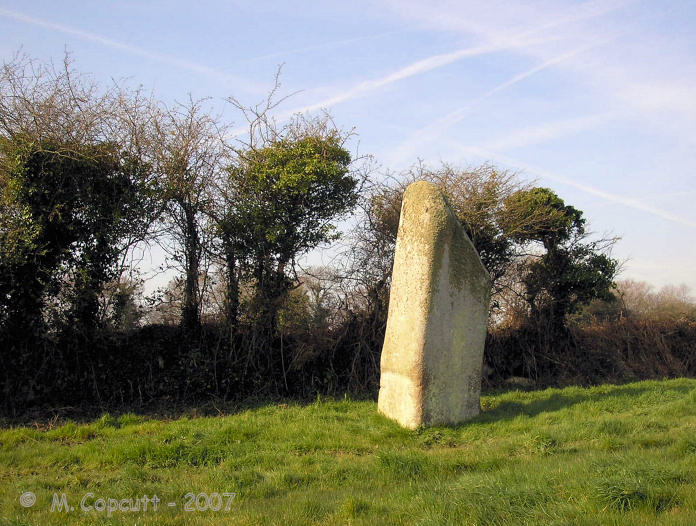
La Longue Pierre (St-Pierre-Eglise) submitted by TheCaptain on 29th Sep 2007. One of the "Three Princesses", this menhir stands 4.2 metres high, perhaps the largest menhir remaining standing in La Manche today.
(View photo, vote or add a comment)
Log Text: I was able to get right to this lovely stone this time, although in a rush as there was nowhere to park and I left the car blocking the little lane. The stone stands about 4 metres tall in a very swampy field, and I got soaking wet feet while walking up to the stone, but at least it washed clean all the mud from La Pierre Plantée. It now has a little information post at the gateway to the field, and is numbered on a marked walk around the village, so I must go and look for more information at St Pierre l'Eglise.
La Pierre Cornue
Trip No.202 Entry No.11 Date Added: 25th Mar 2020
Site Type: Standing Stone (Menhir)
Country: France (Normandie:Calvados (14))
Visited: Yes on 23rd Apr 2005. My rating: Condition 4 Ambience 3 Access 5

La Pierre Cornue submitted by TheCaptain on 6th May 2005. La Pierre Cornue, a more than 4 metres tall menhir.
(View photo, vote or add a comment)
Log Text: A very large menhir in disturbed ground which looks to be an old stone quarry just behind the Mairie which is just to the west of the main street a few hundred metres south of the church. The menhir is made of a strange sort of stony conglomerate and is a strange shape and contains many holes. It is more than 4 metres high 2.5 metres wide and over a metre thick at the base although the main part of the stone is about half a metre thick.
La Butte du Hu
Trip No.202 Entry No.10 Date Added: 25th Mar 2020
Site Type: Chambered Cairn
Country: France (Normandie:Calvados (14))
Visited: Saw from a distance on 23rd Apr 2005
La Butte du Hu submitted by thecaptain on 8th Oct 2006. Plan of La Butte du Hu, Ernes, as shown on the sign at Colombiers-sur-Seulles.
(View photo, vote or add a comment)
Log Text: North of the village of Ernes several hundred metres up a farm track from the hamlet of Vey d’Ifs on the top of the ridge this large chambered tumulus can be seen just within a field growing crops so I did not enter.
Bretteville-le-Rabet
Trip No.202 Entry No.9 Date Added: 25th Mar 2020
Site Type: Ancient Mine, Quarry or other Industry
Country: France (Normandie:Calvados (14))
Visited: Yes on 23rd Apr 2005. My rating: Condition 2 Ambience 2 Access 5

Bretteville-le-Rabet submitted by TheCaptain on 8th May 2005. Bretteville-le-Rabet flint quarries, Calvados.
I spent just 5 minutes looking around the edge of this freshly ploughed field and found four bits of worked flint, including a nice scraper tool.
(View photo, vote or add a comment)
Log Text: Not marked on any map I was told of this place by a man who collects flint artefacts I met at Cairon so I went for a quick look. Nothing much to see but the fields here were freshly ploughed and within 5 minutes of looking along the edges of the fields by the roadside I had found 4 worked flint artefacts.
Pierre Tourneresse (Gouvix)
Trip No.202 Entry No.8 Date Added: 25th Mar 2020
Site Type: Standing Stone (Menhir)
Country: France (Normandie:Calvados (14))
Visited: Couldn't find on 23rd Apr 2005
Pierre Tourneresse (Gouvix) submitted by Rida on 29th Jan 2011. Site in Normandie:Calvados (14) France
(View photo, vote or add a comment)
Log Text: Not marked on my ign map and finding no map within the village I gave up without really trying to find the supposed menhir near here. I believe it is in the grounds of the local chateau and wasn’t going to spend a lot of time being unable to find it.
La Hoguette
Trip No.202 Entry No.7 Date Added: 25th Mar 2020
Site Type: Chambered Tomb
Country: France (Normandie:Calvados (14))
Visited: Yes on 23rd Apr 2005. My rating: Condition 1 Ambience 1 Access 5

La Hoguette submitted by TheCaptain on 6th May 2005. La Hoguette Tumulus, Fontenay-le Marmion, Calvados.
Despite all my records stating that this large round tumulus with 8 passage graves no longer exists, the remains are quite easy to find within the village. It remains today as a green grassy area within a housing estate, surrounded by roads called something like Rue la Tumulus and Rue La Hoguette. There is a large diameter mound with a slight hollow in the middle, and remains of some form of signpost.
(View photo, vote or add a comment)
Log Text: Despite all records stating that this large round tumulus with 8 passage graves is no longer there the remains are quite easy to find within the village. It remains today as a green grassy area within a housing estate surrounded by roads called something like Rue la Tumulus and Rue La Hoguette. There is a large diameter mound with a slight hollow in the middle and remains of some form of signpost.
La Hogue
Trip No.202 Entry No.6 Date Added: 25th Mar 2020
Site Type: Chambered Tomb
Country: France (Normandie:Calvados (14))
Visited: Saw from a distance on 23rd Apr 2005
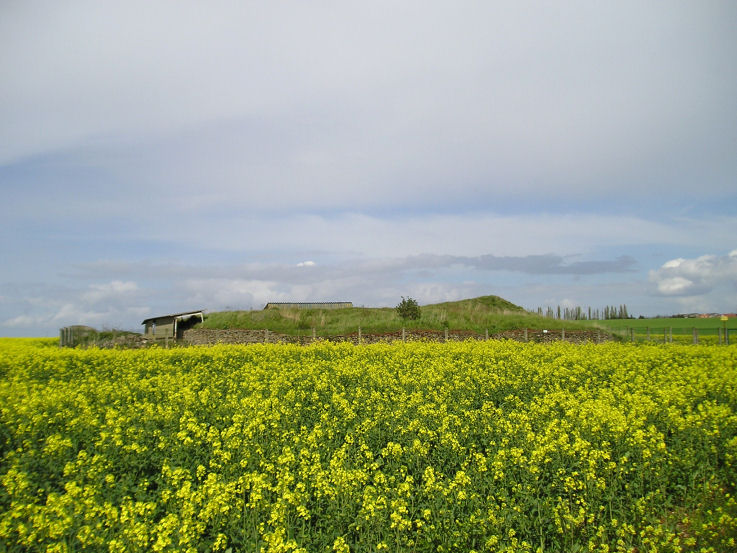
La Hogue submitted by TheCaptain on 6th May 2005. La Hogue Tumulus, Fontenay-le Marmion, Calvados
The excavated remains of this large round barrow with 12 internal burial chambers is fenced off within a field of rapeseed. What was once a guardian with a key to the site in the nearby house was today a lady who told me that “Il est fermée monsieur”.
(View photo, vote or add a comment)
Log Text: Despite being signed from the main road and having a Bar le Tumulus nearby the excavated remains of this large round barrow with 12 internal burial chambers is fenced off within a field of rapeseed. What was once a guardian with a key to the site in the nearby house was today a lady who told me that “Il est fermée monsieur”.
Pierre Tourneresse, Cairon
Trip No.202 Entry No.5 Date Added: 25th Mar 2020
Site Type: Chambered Tomb
Country: France (Normandie:Calvados (14))
Visited: Yes on 23rd Apr 2005. My rating: Condition 4 Ambience 4 Access 4
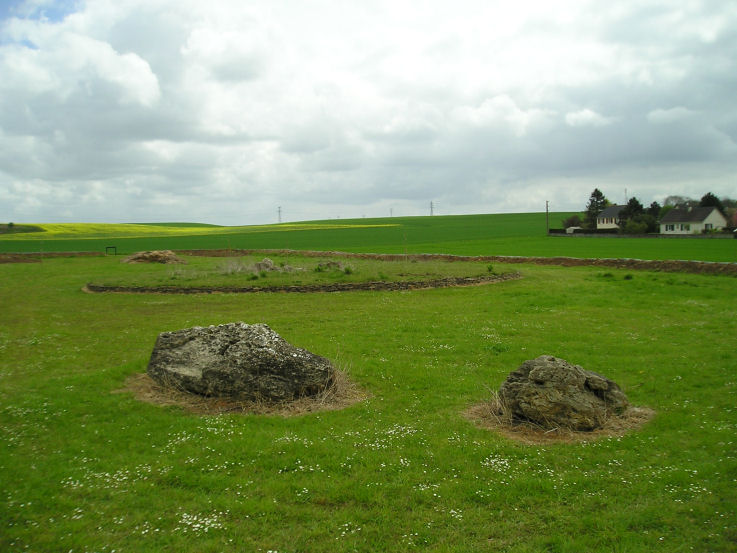
Pierre Tourneresse, Cairon submitted by thecaptain on 28th Apr 2005. Pierre Tourneresse, Cairon. Seen here looking towards the remains of the large round burial mound from beyond the two large stones which are the remains of the capstone from the main chamber - removed and destroyed by the Germans during the '39-45 war.
(View photo, vote or add a comment)
Log Text: I wasn’t expecting to find much here if anything at all as all the information I had of this site was a menhir symbol on my ign map. But as I was passing I decided to have a look anyway and luckily stopped to look at my map right by a little road at the east of the southern end of the village with a sign to “Pierre Tourneresse”. So I followed it down to the end of a little modern housing estate and parked. A further signpost at the end of the road points to Pierre Tourneresse 300 metres distant. Turn left here and stick to the back of the houses rather than go straight on up the hill.
What a lovely site this is. In a little dip down near the stream is a newly made and signposted enclosure which at the time of my visit was still under construction with a ring of trees being planted well around the outside of it. Inside the enclosure is the remains of a large approximately round cairn which has a diameter of about 19 metres and is edged all around with dry stone walling within which are two chambers.
The main chamber is large stone lined chamber in approximately the middle of the cairn which has a seven metre long entrance passage which exits to the east of the cairn at a bearing of 100° magnetic. The chamber is approximately rectangular dimensions about 4 to 5 metres in length by 3 metres in width and is made with large upright slabs with drystone walling between. At various positions around this large chamber there seem to be smaller alcoves or features. The second much smaller chamber opens to the west side and is positioned approximately opposite to the main chamber entrance with an alignment of 269°. It is about 3.5 metres long and opens up to about 2 metres in width at its maximum. It is made with drystone walling only and has a ledge of some sort along its northern side.
Outside the cairn at a distance of about 15 metres in a northwesterly direction are two very large stones. I wondered whether these were once menhirs which marked the position of the cairn (these northern French cairns are often associated with menhirs) and which would explain the marking of menhir on the ign maps. Looking at these stones more closely however suggested that it is much too wide to have been a menhir so I wondered whether the stones were the remains of the chamber capstone. I spent quite a lot of time here the place seemed to give off a nice happy atmosphere which was probably helped by the fact that for once one of these much neglected ancient Normandy monuments is being lovingly cared for and looked after what was probably many years of neglect.
As I was leaving I met a man walking his dog and asked if he knew anything about the site. By an amazing stroke of luck I had met one of the few people in France who has an interest in these ancient sites and who collects flint artefacts ! Despite the language problems we talked for about half an hour about things. He told me that the cairn had been much more complete up until the war during which the Germans had used it as a shelter and gun emplacement. As they were leaving after the D-Day invasion they went about destroying it and the two large stones are indeed the remains of the capstone to the main chamber. He also told me that an excavation of the site was done 5 years ago and the restoration has been going on since then.
We got on to discussing other sites in the region and other than the various sites I knew about (he was surprised indeed to find an Englishman who knew anything about any of these places and seemed very interested when I told him I intended to write a book) and he told me of a menhir nearby he knew which was destroyed only a couple of years ago by a farmer who didn’t want it in the middle of one of his fields. He also showed me on my map a couple of places where he goes to find flint items one of which he called a quarry. He said that if I went to one of these places he showed me then if the fields were recently ploughed I would almost certainly find some worked flint items and that he had a collection of over 700 items. He also then told me in detail how to find the two polisher stones near Mont Joly which was of great interest as I would probably not have even looked if I had no detailed information to go on. It was very nice to meet a man like this particularly on my first real day of French stonehunting and it made me think that the whole trip is going to go well.
Menhir de la Demoiselle de Bracqueville
Trip No.202 Entry No.4 Date Added: 25th Mar 2020
Site Type: Standing Stone (Menhir)
Country: France (Normandie:Calvados (14))
Visited: Couldn't find on 23rd Apr 2005
Menhir de la Demoiselle de Bracqueville submitted by thecaptain on 11th Oct 2006. la Demoiselle de Bracqueville, near Caen in Calvados. Its about 1.4 metres tall, and leans towards the north.
The farmer has left very little room around it, and it has some very recent scrapes and damage done to it, no doubt from farm machinery.
(View photo, vote or add a comment)
Log Text: Despite being marked on the ign map and having a description of how to find this 1.4 metre tall stone I could find no reasonable place to park down the farm track to Bracqueville before a 500 metre walk so didn’t bother. I could see no sign of the stone from anywhere in the vicinity.
Menhir de la Demoiselle de Bracqueville
Trip No.206 Entry No.5 Date Added: 25th Mar 2020
Site Type: Standing Stone (Menhir)
Country: France (Normandie:Calvados (14))
Visited: Yes on 28th Sep 2006. My rating: Condition 3 Ambience 3 Access 4
Menhir de la Demoiselle de Bracqueville submitted by thecaptain on 11th Oct 2006. To visit this stone, find your way from Beny-sur-Mer to the south along small tracks to Bracqueville farm. Park near to the farm, and walk about 500 metres along the track which passes in front of the farm till you get to a junction of trackways. Take the grassy track to the left, and the menhir is a further 500 metres along and just into the field on the left.
(View photo, vote or add a comment)
Log Text: Found this at last, on probably my third attempt. Find your way from Beny-sur-Mer to the south along small tracks to Bracqueville farm. Park near to the farm, and walk about 500 metres along the track which passes in front of the farm till you get to a junction of trackways. Take the grassy track to the left, and the menhir is a further 500 metres along and just into the field on the left.
Its about 1.4 metres tall, 0.7 metres wide and 0.3 metres thick, and leaning towards the north. The farmer has left very little room around it, and it has some very recent scrapes and damage done to it, no doubt from farm machinery. It is likely that this menhir often gets obscured by crops in the summer. Nice to have found it, its a nice stone. Stupidly I forgot to take my gps with me to get a proper position.
Menhir dit Pierre Debout (Reviers)
Trip No.206 Entry No.6 Date Added: 25th Mar 2020
Site Type: Standing Stone (Menhir)
Country: France (Normandie:Calvados (14))
Visited: Yes on 28th Sep 2006. My rating: Condition 2 Ambience 3 Access 4
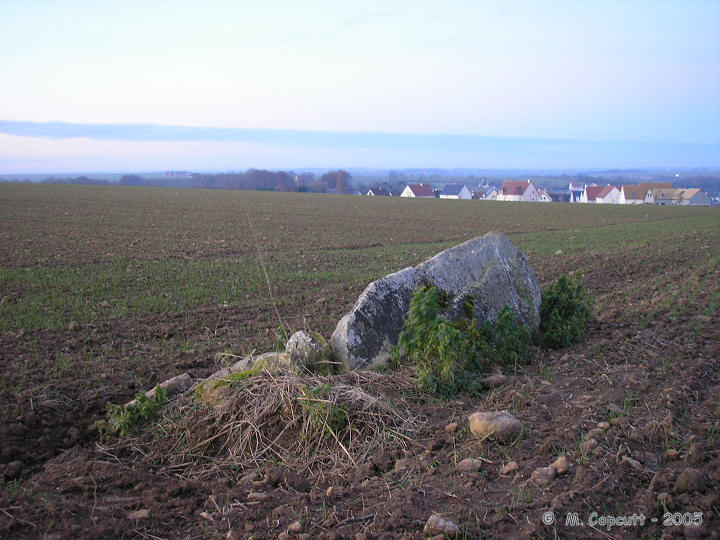
Menhir dit Pierre Debout (Reviers) submitted by thecaptain on 29th Dec 2005. Reviers menhir.
Just inland from the D-Day beaches can be found (when the crops are down) the sad remains of this menhir.
(View photo, vote or add a comment)
Log Text: As I am right here and passing by, thought I may as well stop and take a look in the daylight. The crops in the field are growing, or more likely its been left fallow, but the ploughs have been right up to the stone and its fairly difficult to spot, even with this small growth. The poor stone is in a very sorry state, and could do with some TLC. Shame its so woefully looked after, so close to the well maintained large barrow.
Menhir dit Pierre Debout (Reviers)
Trip No.202 Entry No.3 Date Added: 25th Mar 2020
Site Type: Standing Stone (Menhir)
Country: France (Normandie:Calvados (14))
Visited: Couldn't find on 29th Dec 2005

Menhir dit Pierre Debout (Reviers) submitted by thecaptain on 29th Dec 2005. Reviers menhir.
Just inland from the D-Day beaches can be found (when the crops are down) the sad remains of this menhir.
(View photo, vote or add a comment)
Log Text: Despite being marked on the ign map and having a good look all around I could find no sign of any menhir here. Perhaps it is fallen and somewhere within a field of oilseed Rape.
Later note. Having seen the 1:25000 ign map of the area the menhir is marked fairly close to the corner of the road and farm track right where I was looking originally. As I suspected the menhir must be fallen and hidden within the crop.
Colombiers-sur-Seulles tumulus
Trip No.202 Entry No.2 Date Added: 25th Mar 2020
Site Type: Chambered Tomb
Country: France (Normandie:Calvados (14))
Visited: Yes on 23rd Apr 2005. My rating: Condition 4 Ambience 4 Access 5

Colombiers-sur-Seulles tumulus submitted by TheCaptain on 7th May 2005. Colombiers-sur-Seulles tumulus, Calvados.
The circular burial chamber in the northern side of the mound.
(View photo, vote or add a comment)
Log Text: A long barrow which has been excavated and destroyed several times in the past but which has recently been restored to some form of its former glory by local enthusiasts. It is situated about half a kilometre east of the village just beyond the menhir signposted in a little copsed area just south of the road.
The barrow is about 50 metres in length and about 9 metres in width at the narrow west end and 18 metres width at the wide eastern end with an orientation of 280°. It is about 5 metres in height at its maximum and has several drystone walled sections running around it. In the middle of the mound is a little circular burial chamber about 2.5 metres in diameter with its entrance chamber running from the north side at an orientation of 010°. The chamber is made using 6 large upright stones with drystone walling between them but how much is now original is not known. The view along the entrance chamber does not see over the local horizon which is just a hundred metres or so distant. At the smaller western end there is a pair of large upright stones set into the external wall and as far as I can find once formed the entrance to another smaller burial chamber.
This is obviously now a well looked after and cared for monument set within a fenced off area using rustic fencing and also within the area are a mock up of an ancient oven and some hearths. with drystone walling between them but how much is now original is not known.
Menhir des Demoiselles (Colombiers-sur-Seulles)
Trip No.202 Entry No.1 Date Added: 25th Mar 2020
Site Type: Standing Stone (Menhir)
Country: France (Normandie:Calvados (14))
Visited: Yes on 23rd Apr 2005. My rating: Condition 3 Ambience 3 Access 5
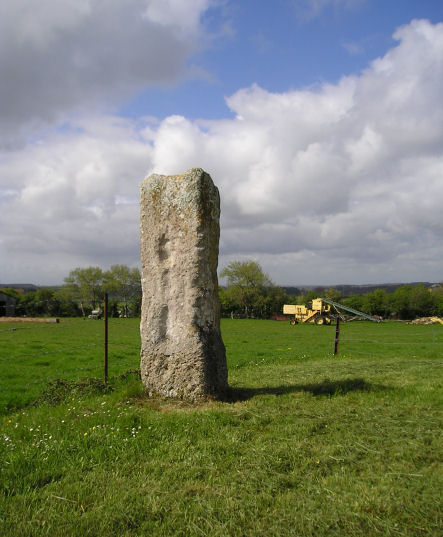
Menhir des Demoiselles (Colombiers-sur-Seulles) submitted by thecaptain on 28th Apr 2005. Just over 2 metres in height, this menhir is set in its own little grassy area beside the road junction just uphill to the east of the village. It is a square pillar with several holes and indentations, and has been broken in the past at both top and bottom (probably during the war) and is now remounted on a concrete post. While I was here it was sunny between the clouds, there was a bike race going on past the stone, and an old warplane flying above, which all added to a nice French rural scen...
(View photo, vote or add a comment)
Log Text: Just over 2 metres in height this menhir is set in its own little grassy area beside the road junction just uphill to the east of the village. It is a square pillar with several holes and indentations and has been broken in the past at both top and bottom (probably during the war) and is now remounted on a concrete post.
While I was here it was sunny between the clouds there was a bike race going on past the stone and an old warplane flying above which all added to a nice French rural scene
Pierrelaye menhir
Trip No.201 Entry No.6 Date Added: 25th Mar 2020
Site Type: Standing Stone (Menhir)
Country: France (Normandie:Calvados (14))
Visited: Couldn't find on 21st Nov 2004

Pierrelaye menhir submitted by Rida on 6th Feb 2011. Site in Normandie:Calvados (14) France
(View photo, vote or add a comment)
Log Text: On a wet Sunday afternoon, following the disappointment of not getting to see the Pierre Dialan dolmen, my family encouraged me to go and find the nearby Menhir de Pierrelaye, which is marked on the IGN maps to the north of the village of Villers-Bocage.
My first attempt to get to see this 3 metre high stone was via the lane from the southeast, but upon reaching a farmyard there was no further way through. To much amusement getting out from here involved reversing all the way back up this lane to the road junction, a distance of about a mile ! Not to be beaten, I drove round the lanes to try and get a look from the northwest of where the stone is marked. The collection of farms and houses here is known as Pierrelaye, and indeed have signposts to Pierrelaye, but I could see no traces of a Menhir.
While turning round in a farmyard, an old farmer came out to see what was going on, so we asked in bad French where the stone was. After a while, he obviously realised what we were looking for and pointed up the hillside and said “Non monsieur, Fermée” while making arm gestures which made it clear I wasn’t going to see the stone. I assume it is on private land, and he wasn’t going to give me permission to go have a look. I have found information which tells that the stone is 3 metres high, with a base width of 2,5 metres, made of schist. It is situated in the middle of a field in a little valley.
Pierre Dialan
Trip No.201 Entry No.5 Date Added: 25th Mar 2020
Site Type: Burial Chamber or Dolmen
Country: France (Normandie:Calvados (14))
Visited: Yes on 21st Nov 2004

Pierre Dialan submitted by thecaptain on 9th Dec 2004. Dolmen la Pierre Dialan, Jurques, Calvados, France.
Seen on a wet afternoon through the forest, this is the best I got to see this pile of old stones, using a telephoto lens. All the local villagers were out having a hunt through the woods, and straying from the track through the forest was distinctly disencouraged.
(View photo, vote or add a comment)
Log Text: To the south of the village of Jurques the D.577 road curves its way up and over a forested ridge. At the top of this hill to the east of the road is a small picnic site and a signpost to La Pierre Dialan dolmen, highlighted as a tourist place on the IGN maps. Walk about 500 metres along the track through the forest and on the right, just before the woods end, about 40 metres from the path can be seen a pile of large stones, now becoming closely surrounded by a very large gravel quarry cutting its way into the hillside.
Unfortunately I cannot be 100% sure that this is the actual Dolmen, as on the day of my visit, in pouring rain, there was a hunt going on, with many men out with their dogs, rifles and horns. Although the huntsmen would let me walk down the forest track, I was warned not to stray from the path, unless I wanted to be shot, so I couldn’t get to see the Pierre Dialan properly !
It was disappointing to not get to see the stones, but an interesting wet afternoon in the forest nonetheless, which caused much amusement telling the story to my waiting sister and nephew in the car at the picnic site. I have since found some information which says that this is possibly a natural rock outcrop.
Allée Couverte d'Haye d'Ectot
Trip No.201 Entry No.20 Date Added: 25th Mar 2020
Site Type: Passage Grave
Country: France (Normandie:Manche (50))
Visited: Couldn't find on 22nd Nov 2004
Allée Couverte d'Haye d'Ectot submitted by TheCaptain on 10th Feb 2017. Carl Ashcroft sends us this picture with the following description.
I have tried to find the allee couverte at La Haye d'Ectot but could not using the location on the map on your site which is just off the D130. I looked around the area for a whole morning. Unfortunately the Mairie is closed until January. However I did bump into a man out hunting who directed me to what he believed was the correct site in a different valley further north over the other side of the valley and closer to the spr...
(View photo, vote or add a comment)
Log Text: To the south of Moitiers d'Allonne is the community of La Haye D’Ectot, which supposedly has its own Allée Couverte, which is often confused with the above. Not marked on any maps I have, I called in at the village admin centre, at this time of day now closed. Outside this was the community map and footpath guide with places of interest marked on it, but I could find no reference to any megalithic monument.
Autel des Druides des Moitiers d'Allonne
Trip No.201 Entry No.19 Date Added: 25th Mar 2020
Site Type: Passage Grave
Country: France (Normandie:Manche (50))
Visited: Yes on 22nd Nov 2004. My rating: Condition 3 Ambience 3 Access 4

Autel des Druides des Moitiers d'Allonne submitted by thecaptain on 20th Dec 2004. Autel des Druides des Moitiers d'Allonne Allée Couverte in Manche, Normandy, as seen from the west at the entrance to its field.
(View photo, vote or add a comment)
Log Text: To the east of Moitiers d'Allonne, just a few miles northeast of Barneville-Carteret, can be found “Autel des Druides des Moitiers d'Allonne”, also known as the Allée Couverte de Grand Breuil. Situated near the top of a hill along a small road north of the D.902, this monument can be found signposted down a farm trackway, but finding anywhere to park in the vicinity was not easy. It is also signposted from the village of Les Moitiers d'Allonne.
Approximately 20 metres in length, and on a north – south axis, this Allée Couverte was rebuilt in the 1960’s after having been partially buried and used as a cattle shelter. The width between the two rows of stones is about 1.5 to 2 metres, and there are at least 6 capstones in place with a height of about 1.5 metres underneath. When I was there, the Northern half of the Allée was clear of vegetation and open to get inside, while the southern half was in a very overgrown state. The surrounding field had been ploughed right up to the edges of the monument, and in some places at the south end damage had occurred.
